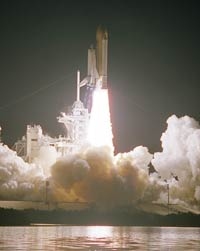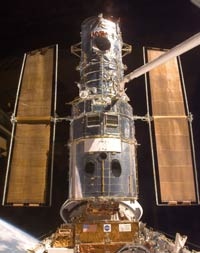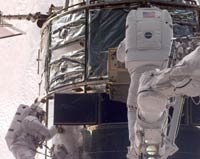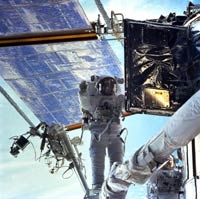Servicing Mission 3A
After months of delays because of wiring defects, an engine swap and replacement of a crushed liquid hydrogen line, NASA launched Discovery into space on Hubble Servicing Mission 3A in December 1999.
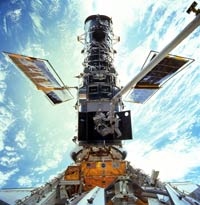 |
|
Payload commander Steven Smith and mission specialist John Grunsfeld are installing Hubble's new gyroscopes. |
This mission was especially important since Hubble had been in a so-called safe mode since November 1999. The safe mode - which prevents observations - was triggered by the failure of a fourth gyroscope (out of six gyroscopes onboard Hubble). A minimum of three gyros are required to control where Hubble points in space. Hubble's gyroscopes have been the cause of some concern in the past few years. Four of them have failed since the Second Servicing Mission in 1997.
The Servicing Mission was performed without problems and, apart from changing all gyros, a few other important servicing and up-grading tasks were carried out during three spacewalks.
Mission achievements
- Hubble's six gyroscopes were replaced
- six so-called voltage/temperature kits were replaced
- Hubble's main computer was replaced with a more modern 486 model
- a Fine Guidance Sensor was replaced
- a faulty radio transmitter was replaced
- a data tape recorder was exchanged
- a number of thermal insulation blankets on the outside of Hubble were replaced
Event breakdown
Within two days of the launch, Discovery, with its crew of seven astronauts, had manoeuvred close enough to Hubble so that ESA astronaut Jean-François Clervoy was able to grapple the telescope with the Shuttle's robotic arm.
The first of three scheduled spacewalks took place from 19:55 CET on Wednesday 22 December 1999 to 04:10 CET on 23 December 1999. At 8 hours and 15 minutes this was the second longest space walk ever. On this space walk astronauts Smith and Grunsfeld managed to replace all of the six gyros onboard Hubble. The news of this achievement was naturally received with great pleasure and relief by the entire astronomical community. On this space walk six so-called voltage/temperature kits were also replaced. They prevent Hubble's batteries from overcharging.
The second space walk took place from 20:06 CET on Thursday 23 December 1999 to 04:16 CET on 24 December 1999. Again a record length space walk lasting 8 hours and 10 minutes. Hubble's main computer was replaced with a more modern 486 model. The new computer will enable Hubble to calculate 20 times faster and its RAM has room for six times the amount of data compared with the old computer. The team - NASA's Michael Foale and ESA's Claude Nicollier - also managed to exchange a Fine Guidance Sensor, which is used to point Hubble at the objects to be observed. These sensors can also be used to make a special type of observations known as astrometry - or 'position-measurements'. The only tension during this space walk occurred when Nicollier and Foale worked intensively for some minutes on sliding the sensor into place.
On the third spacewalk from 20:17 CET on Friday 24 December 1999 to 04:25 CET on 25 December 1999 (8 hours 8 minutes) a faulty radio transmitter and a data tape recorder were exchanged. Thermal insulation blankets on the outside of Hubble were also replaced, although not all of the planned work on this was carried out. There is no doubt that the achievements of the three spacewalks during this third Servicing Mission will enter into the history books.
Hubble was released after preliminary tests had shown that all systems - new as well as old - were performing perfectly.
 |
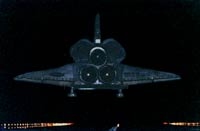 |
|
Discovery slowly backs away from Hubble after the release. |
Discovery's night-time landing also went smoothly. |
At precisely 00:03 CET on Sunday 26 December 1999 Clervoy released the telescope with the robotic arm. Discovery then backed slowly away from Hubble and the astronauts used the remaining time in space to stow equipment away as well as making other preparations for the landing.
At 01:01 CET on 28 December 1999 Discovery touched down on the runway at Kennedy Space Center. During the mission Discovery circled the Earth 119 times and travelled more than 5 million kilometres.
The immense success of this mission has ensured that Hubble is now well prepared for the many years of observing to come.

